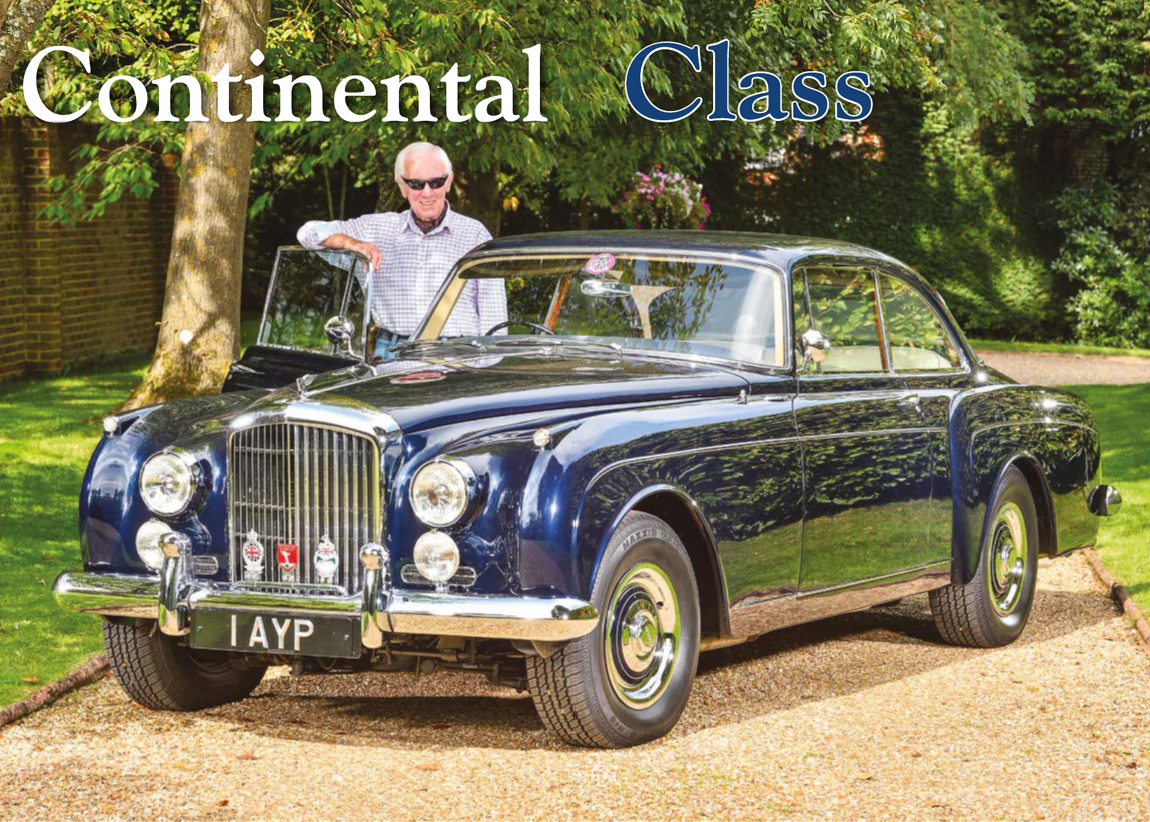
Alan Peck’s lifelong ambition to own a Continental fastback took a different direction when he opted for an S2 two-door ‘booted’ version instead – one that has been transformed into a prize-winning gem, writes Paul Guinness. Images: Courtesy of Matt Woods. Article reproduced with kind permission of Rolls-Royce & Bentley Driver magazine (shop.kelsey.co.uk/rrandb)
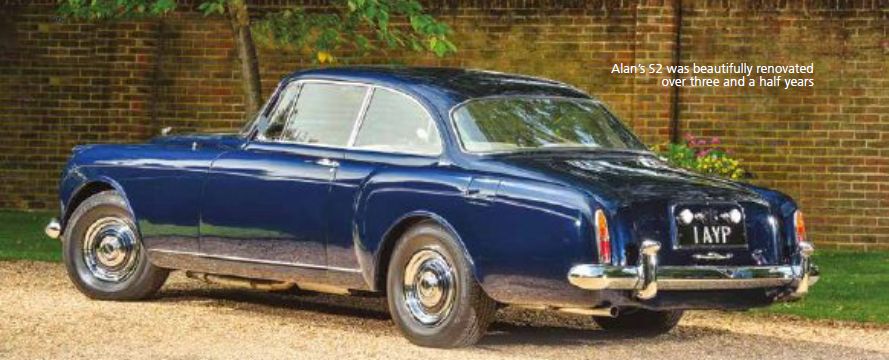
Back in the late 1950s, when I was on a management course at Claridge’s, I’d often find myself looking through the window of the nearby Jack Barclay showroom, admiring the lines of the Bentley Continental fastback,” smiled Alan Peck, a now-retired hotelier and restaurateur who lives in a picturesque village in rural Surrey. As one of the most expensive cars of its time, the HJ Mullinerbuilt model was the stuff of dreams for a young man just starting out on his career. But in more recent years, Alan has finally been able to fulfil his Continental ambitions… albeit with a twist.
“When I retired, I decided it was the right time to buy one of these now-classic models,” explained Alan. “I drove a number of available examples but was unable to find the right one, with the kind of history file I was looking for.” The other issue facing Alan was more of a domestic one: “My wife, Wendy, wasn’t a fan of the fastback Continental. She didn’t like the design at the back. Although it’s a classic, she simply wasn’t keen on it.”
Alan then had a phone call from Paul Brightman of Royce Service & Engineering, who told him about an S2 Continental Mulliner two-door that the company had maintained for a number of years. When its owner (Tony Ryan of Ryanair fame) passed away, the car was acquired by RS&E, who became its latest custodian until a deal was finally struck with Alan: “I was a little apprehensive until I actually drove the Bentley and could then appreciate its effortless V8 power and its smooth automatic gear changes. This was a car that was capable of speeds well in excess of 100mph when new.” The other reason for opting for this handsome two-door coupé was the positive reaction at home, recalled Alan: “As soon as she saw it, Wendy said ‘Oh, I like that, it’s got a beautiful line to it.’ She thought it was far more attractive than the fastback models I was originally looking at.” The downside, however, was that the S2’s aesthetic condition left a lot to be desired, although it was mechanically sound thanks to relatively recent work carried out by the team at RS&E: “The car had been treated to an engine rebuild, a new exhaust system, and a front suspension and brake overhaul, but it needed some bodywork attention. I asked Paul and Patrick [at RS&E] what it would cost to make the car spotless, and on the strength of that estimate I bought it.”
Work began on the S2 in the spring of 2013, the idea being to strip the bodywork back to bare metal in order to carry out the necessary repairs, as well as fully restoring the car’s interior and exterior trim to a high standard. It was decided that all such work could be carried out with the body still in situ, particularly as there was no intention of aiming for a concours style standard of finish. As is so often the case, however, expectations rose as the project progressed, with Alan becoming increasingly involved in the restoration: “I’m a bit of a perfectionist,” he confessed, “and I’d call in on Paul, Patrick and the team every couple of weeks to check on how things were going.” Perhaps inevitably, discussions soon turned to transforming the S2 into a potential concours d’elegance contender, with Alan being increasingly impressed by the ongoing work each time he visited. The project was being overseen by RS&E’s Richard Simmons, a man with a keen eye for perfection and real attention to detail… much to Alan’s delight.
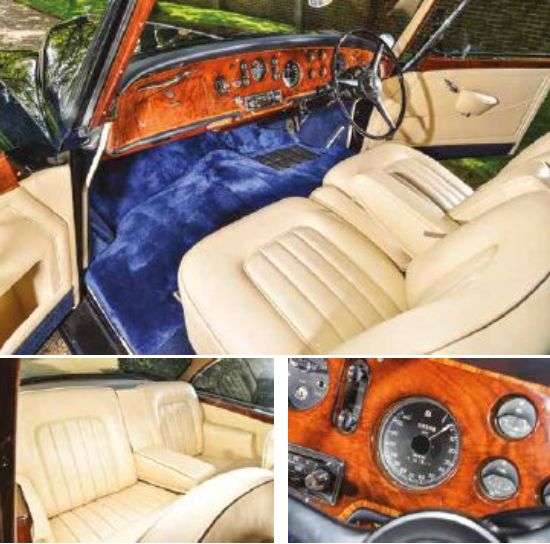
The interior is immaculately presented, with new Connolly Vaumol hide and fully restored woodwork
The bodywork repairs proved to be a particular challenge, with the sills needing plenty of work. A steel plate runs through the centre, with aluminium bracketry bolted to it; but with the age-old issue of corrosion setting in where steel and aluminium meet, the various pieces were becoming separated. The only solution was to fabricate new steel and alloy sections and begin a gradual build-up of the sills virtually from scratch, with modernstyle protection being incorporated throughout to ensure the same problem never recurs. Such issues weren’t just confined to the sills, however, with RS&E cutting away sections of aluminium from other panels only to discover corrosion issues with the mountings, which then had to be carefully replaced by hand-crafted replicas.
The nearside rear wing was also suffering from fairly major corrosion, particularly around the petrol cap door, with previous poor repairs having to be cut out and fresh metal carefully shaped and fitted. This was, of course, all very time-consuming, as was the process of panel alignment – particularly the doors, which obviously weigh less when fully stripped and therefore proved a challenge when it came to getting the panel gaps and shut lines all perfect. A huge amount of time went into making sure everything was just so, but all the while a question mark hung over how the car should be finished. Or rather, what colour it should be.
The S2 had started out as a Tudor Grey example, only to be resprayed in Masons Black in later life. Alan, however, had other ideas: “I wanted a colour that I thought would really suit the lines of the car, one that would make it stand out.” Various tests were carried out on a Silver Shadow bonnet, with numerous different shades being tried until Alan and Wendy finally found the one they liked above all others: Midnight Blue, a modern colour from the Volkswagen range, with just the merest hint of metallic content to help make it sparkle.
“I think it’s perfect for the car,” said Alan, “and I’ve never had an issue with it being a non-Bentley colour, although some traditionalists might not approve.” The paintwork itself was expertly applied by Surrey-based Calbrook Coachworks, who managed to achieve the high standard of finish that Alan was after. The engine bay, bulkhead and back of the bonnet were sprayed in the correct factory-finishing hue, with RS&E then reinstating the car’s original 6230cc V8 and all ancillaries to a concours-like standard, demonstrating an exemplary level of engine bay detailing.
With attention turning to the interior, the S2’s extensive woodwork was sent to specialist Joe Crabtree for restoration, while Derby Plating was tasked with restoring the car’s hefty chromework. But Alan and Wendy faced another dilemma when it came to choosing the leather colour scheme, with the initial idea of magnolia with blue piping being dismissed as too modern looking. The cream-coloured Connolly Vaumol hide that was eventually decided upon does indeed suit the car, as does the contrasting blue carpeting. The same carpet extends into the S2’s generously proportioned boot, where you’ll find the authentic and fully detailed tool kit that was also restored by RS&E.

Alan is a stickler for detail, hence the beautifully finished boot and restored toolkit. Detailing the engine bay to such a high standard was a time-consuming project
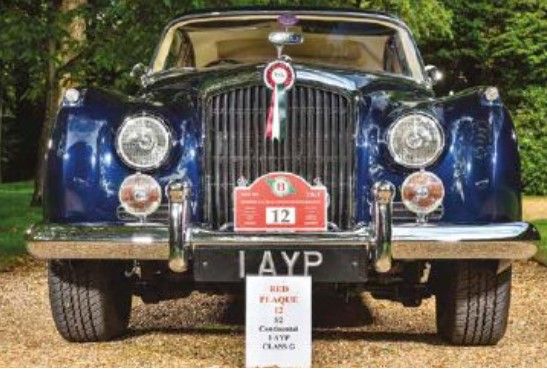
During the decision-making process, Alan opted for a number of subtle but important upgrades for the car, a list that included independently controlled heated seat pads, uprated electric window mechanisms, LED lighting for the boot and Dynamat soundproofing throughout. One particularly clever improvement, though, was the installation of an air-conditioning system that involves no changes to the dashboard, thanks to the condenser being housed in the boot and the cold air being fed into the car through a pair of period looking bull’s-eye vents in the rear parcel shelf, as well as via a discreet centre grille.
From start to finish, the complete rejuvenation of this rather special Continental took around three and a half years. “Words alone cannot explain just how much care and attention went into the meticulous restoration,” admitted Alan, proud owner of one of the finest Bentleys of its type. The ultimate accolade came at the BDC’s 2018 Concours d’Elegance at Stonor Park, Oxfordshire, where the S2 was judged to be the outright winner of its class.
It was a fitting conclusion to a project that had evolved into a massive undertaking for all concerned. But what about Alan’s plans for the future? “We’ve used the Bentley fairly extensively and had been planning to drive it to the south of France for the Monaco Grand Prix, although obviously 2020 hasn’t been a year for driving adventures. Hopefully, we can look forward to putting more miles on it in the not too distant future.” Meanwhile, this beautifully renovated masterpiece seems perfectly at home in Alan’s heated and dehumidified garage, where it patiently awaits its future road trips.
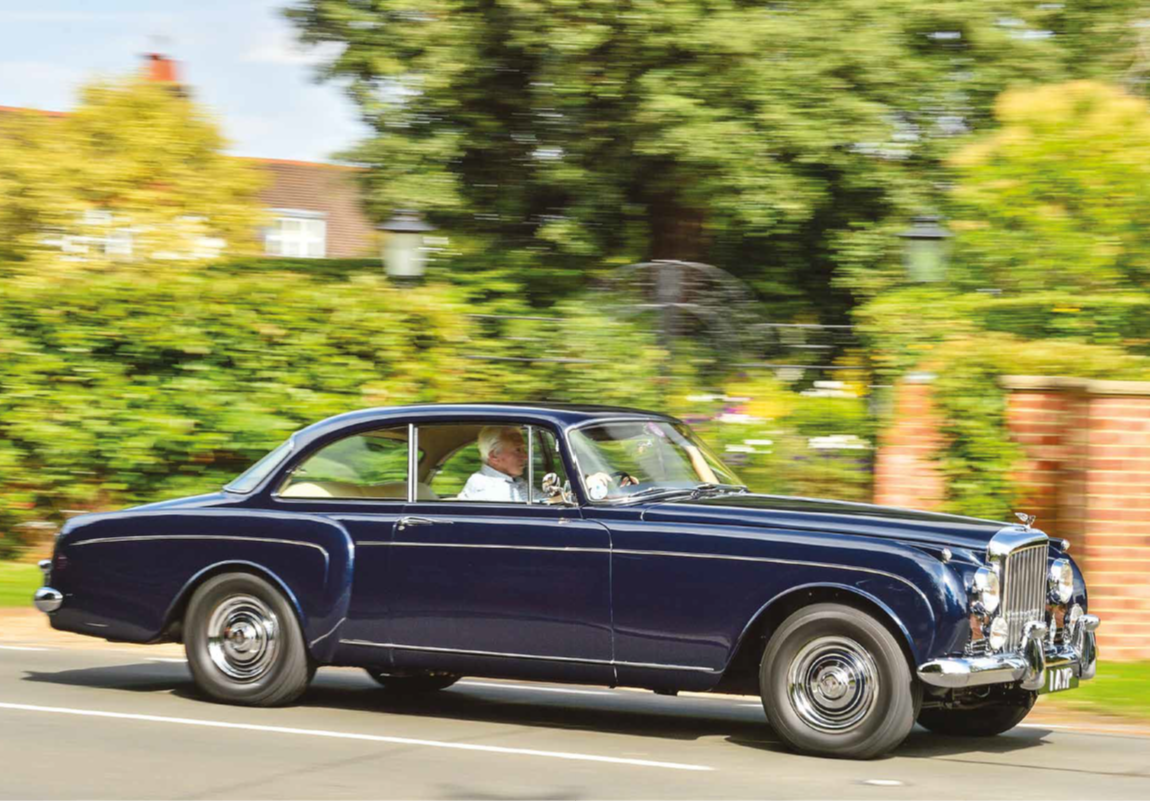
MULLINER RARITY
The fastback design of the HJ Mulliner-built Continental meant restrictions when it came to luggage space, making it less of the perfect longdistance touring machine than its maker might have hoped. The arrival of the Continental Special at the 1958 Earls Court Motor Show provided a solution, although customer resistance to its controversial styling details saw the design modified the following year. This stylistically improved version of the ‘booted’ two-door saw the design carried forward to the subsequent S2 Continental chassis, at which point it was given design number 7514. In Coachwork on Rolls-Royce & Bentley 1945-1965, author James Taylor explains more about this latest offering: “It became the coachbuilder’s standard two-door design for the S2 Continental, and was later modified with the four-headlamp front end for the S3 Continental chassis as well, when it became a product of the Mulliner Park Ward edition. No fewer than 74 examples were built, of which 26 were on left-hand drive chassis.”
Thank you to the Bentley Drivers Club (BDC) for giving us kind permission to use this article on our website.
Become a member of the Bentley Driver Club today, visit www.bdcl.org/membership

